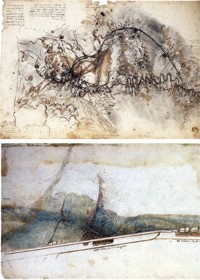Miodrag B. JOVANOVIĆ

Leonardo da Vinci's drawings from 1503/4:
River Arno with flood relief canal (above),
flow diversion structures and quay wall
East of Florence (below).
-
Download (in Serbian only):
- Syllabus
- Lectures (office 155, 358 MB)
- Practicals
- Lab Exercises
- Exam questions
Subject: River Training (up to 2013)
Semester: VIII.
Number of hours: 3+3
ECTS credits: 7
Lectures:
1. River geomorphology.
2. Elements of the boundary layer theory. Friction resistance in natural watercourses.
3. Methods for calculating unsteady and steady open-channel flows.
4. Secondary flows. Origin and properties of river sediments.
5. Incipient motion of sediments.
6. Bedload transport capacity. Bedload field measurements.
7. Liquid-solid (two-phase) flow. Suspended sediments. Concentration profiles.
8. Total load transport capacity. Suspended sediment field measurements.
9. General and local deformation (scour) of the river bed.
10. River morphology. Hydraulic models.
11. River training works: motives, input data, geometric elements, channel tracing.
12. River training structures: types, layout, building elements, construction.
13. Proactive and passive flood control and management.
14. New trends in river training - "natural" regulation of small streams.
15. Design project documentation.
Practicals:
1. Calculation of 1D flows by the HEC-RAS model.
2. Calibration of the Manning flow resistance coefficient. Velocity and shear stress distribution.
3. Calculation of the secondary flow in bends.
4. Statistical analysis of river channel morphology. Design channel width.
5. Calculation of the bedload transport capacity by the Mayer-Peter and Muller method.
6. Calculation of the vertical distribution of concentration and suspended load.
7. LAB EXERCISES (flume with movable bed): measurement of the vertical velocity distribution,
application of the Shields diagram, size and velocity of sand ripples/dunes,
scour around bridge piers of various shapes and flow attack angles.
8. Calculation of the general river bed deformation.
9. Tracing principles of regulated river channels. Choice of river training structures.
10. Design of revetments (stone size, filters, foundation). Revetment drawing.
11. Design of spur-dikes. Optimal distance between spur-dikes. Spur-dike drawing.
12. River bend cut-offs. Tracing the new channel and checking its capacity for self-development.
13. Calculation of flood flows. Design of levees.
13. Writing and presenting a technical report.
Literature:
1. Jovanović, M., River Training - river hydraulics and morphology, Faculty of Civil Eng., 2008 (in Serbian)
2. Jovanović, M., River Training - works and structures, lectures in digital form 2011(in Serbian).
3. Jansen et al., Principles of River Engineering, Pitman, London, 1979.


